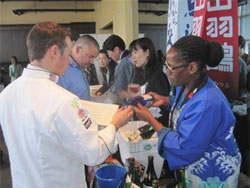Reports and Statistics
Akita Sake Brewers Convinced of Chicago's Sake Market Growth
Nov 2, 2011

Ms.Linda Kawabata (right) and an American chef
Following the success of their May 2011 sake tasting , the Consulate General of Japan at Chicago and JETRO Chicago, in cooperation with Akita Prefecture Government, organized another Japanese Sake Tasting & Pairing for professionals on November 2nd. Held again at Kendall College, this event brought over 85 buyers, chefs, restaurateurs, retailers, wholesalers, and culinary associations, educators and students together with 15 exhibitors promoting their sakes. U.S. importers and distributors as well as five sake brewers from Akita, Japan participated, three of whom are members of the Akita Sake Promotion and Export Council (ASPEC). Akita Prefecture, in the Tohoku region of northern Japan is known for high quality rice farming and is one of the country's most prolific sake brewing regions. Its renowned microbreweries produce a wide range of sakes and attendees were able to try 16 of Akita's best ones. In all, over 60 sake brands and several shochus were offered for sampling so attendees had the opportunity to learn to distinguish between many types, strengths and flavor profiles in one setting.
In opening the afternoon event, Consul General of Japan at Chicago Yoshifumi Okamura explained that sake is a Japanese business person's source of energy that is consumed both at the local izakaya and with family. He invited the guests to take advantage of this great opportunity to try Akita sake produced with the prefecture's famous rice. Sake is often drunk with food and most of the brands exhibited were described along with what foods they pair with best. These ranged from sashimi and light, delicate dishes to hearty or rich fare. Linda Noel Kawabata, USA Brand Manager of ASPEC recommends having soft cheese and liver pate with sake. In presenting an example of a dish which pairs well with many sakes, Chef Shin Thompson, Chef and Owner of Bonsoiree in Chicago, created his umami-rich Thai Curry Lobster Bisque for attendees to taste. Many of his American customers he said are asking which sakes compliment his restaurant's French-Japanese fusion cuisine. Attendees were also given samples of non-Japanese dishes which can be enhanced with sake, for example tempura shrimp with ponzu and tomatoes with mozzarella and basil pesto prepared by Kendall College students.
That same evening, the Japan America Society of Chicago also hosted a sake tasting at a fine Chicago restaurant to educate American consumers in sake. In addition to the sake tastings, brewers from Japan visited Chicago restaurants and fine wine shops and met with restaurateurs, chefs and sommeliers to get reviews of their sakes and to improve their understanding of the local market. Many of Akita's sake brewers were convinced that Chicago's sake market is growing and some of them have already committed to bringing their best sakes to Chicago in the near future.
Promoting Japan's alcohol industry's sales abroad has become a focus of the Japanese government's push to increase Japan's exports of its unique and quality foods and beverages. Mr. Takeshi Oi, President of ASPEC, mentioned Chicago's sake market is growing, especially recently, which is why they chose to come here. More restaurants are expanding their sake lists and many newly opened restaurants offer sake. A representative of the Consulate General office noted that this was the first time to hold two sake events in one year here. The decision was based on the strong interest they felt from area food professionals. Unlike in Los Angeles and New York, Chicago has no large scale sake tastings put on by sake importers or distributors so that is why it is important for the Japanese government bodies to hold these events for the food industry.



